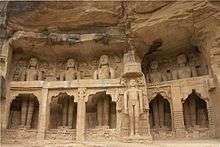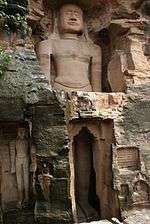Jain sculpture
| Part of a series on |
| Jainism |
|---|
 |
|
Jain prayers |
|
Ethics |
|
Major figures |
|
Major sects |
|
Festivals |
|
Pilgrimages |
|
|
Jain sculptures or Jain idols are the images depicting Tirthankaras (Teaching Gods). These images are worshiped by the followers of Jainism. The sculpture could depict any of the twenty-four tirthankaras with images depicting Parshvanatha, Rishabhanatha, or Mahāvīra being more popular. Jain sculptures are an example of Jain art.[1][2]
Iconography

The Jain idols are always male, depicted in both sitting and standing postures.[3] The tīrthaṅkaras are represented either seated in yoga posture or standing in the Kayotsarga posture.[4] Parshvanatha statues are usually depicted with a snake crown on head, Bahubali statues are usually depicted covered with creepers.[5] However, there are a few differences in Digambara and Svetambara depiction of idols.[3] Digambara images are naked without any beautification whereas Svetambara ones are clothed and decorated with temporary ornaments.[3]
Examples
Giant rock-cut statues of Jain Tirthankaras are carved in the Gopachal Hill, Gwalior, Madhya Pradesh. [6][7]
Charans are footprints exclusive to Jain temples. The charan of Tirthankara Rishabhanatha are present at the Badrinath Temple.
In Tamil Nadu
Jainism spread here and there all over Tamil Nadu during Sangam Age. One of the Tamil literature, called Paripadal (பரிபாடல்), probably belongs to 3rd century, mentions that there were propelling statues sculptured in stone for different deities in the temple of God Murugan in Thirupparankundram. One among them was Jain statue. Others are Kaaman-Rathi (the deities of Love), Deity Indira (the king of so-called Heavenly people according to Indian mythology), Agaligai (wife of Saint Gaudham), and Buddha.
Jain sculptures in Kalugumalai near Madurai belongs to one century latter is to be compared with Thirpparankunram Jain sculpture. In addition a propelling stone statue of a Jain monk mentioned in Tamil literature is also present. Cave inscriptions in Brahmi script of Chera kings in Pugalur probably one century earlier to that of the literature we have taken to our consideration, names some of the Jain Monks vs Yatrur Senkayapan, Pittan, Kotran. Pittan and Kotran are the chieftains of Tamil Nadu also mentioned in Tamil literature more or less to the same period.
In Museums
Many Jain sculptures are kept in Government Museum, Chennai and Government Museum, Mathura. [8] [9]
The oldest Jain sculpture in the Metropolitan Museum of Art in New York is of the Siddha Bahubali.[10]
Gallery

 Converted image of Parshvanatha
Converted image of Parshvanatha




 31 ft statue of Lord Vasupujya at Champapur, Bhagalpur
31 ft statue of Lord Vasupujya at Champapur, Bhagalpur 18 feet idol of Parsvanatha in Parsvanatha Basadi at Shravanabelgola
18 feet idol of Parsvanatha in Parsvanatha Basadi at Shravanabelgola
See also
Notes
- ↑ "Jainism".
- ↑ Asia Society: The Collection In Context
- 1 2 3 Cort 2010.
- ↑ Zimmer 1953, p. 209-210.
- ↑ Pereira 1977, p. 9.
- ↑ worldvisitguide.com
- ↑ Jain sculptures in Gwalior - Abiyoyo
- ↑ "Government Museum Chennai".
- ↑ "Government Museum Chennai".
- ↑ "Jain Siddha Bahubali, Entwined with Forest Vines". The Met’s Heilbrunn Timeline of Art History.
References
- Pereira, José (1977), Monolithic Jinas, Motilal Banarsidass, ISBN 0-8426-1027-8
- Cort, John E. (2010) [1953], Framing the Jina: Narratives of Icons and Idols in Jain History, Oxford University Press, ISBN 978-0-19-538502-1
- Zimmer, Heinrich (1953), Joseph Campbell, ed., Philosophies of India, London, E.C. 4: Routledge & Kegan Paul Ltd, ISBN 978-81-208-0739-6
External links
| Wikimedia Commons has media related to Jain sculptures. |